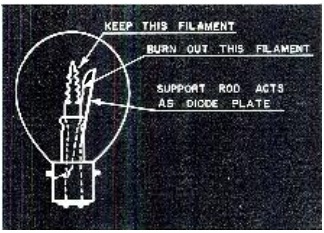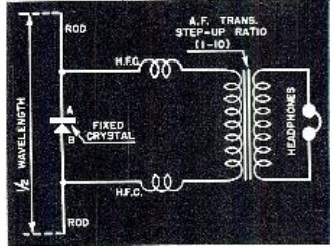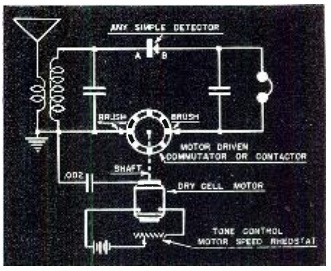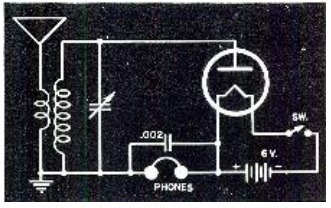A wartime issue of Radio News, January 1943, includes an interesting article entitled “Emergency Radio Receivers.” The article notes that “‘horse and buggy’ receivers employing the simple detectors are just as workable today as they ever were.” With wartime tube and battery shortages, and the possibility of power line disruptions, “the present war emergency may yet recall these simple sets from their resting places on museum shelves.” Their greatest value in time of war was as emergency receivers. “Such sets may be placed into immediate service when power lines have snapped out and “B” batteries are not available for the family portable. They may be carried into bomb shelters where electric power is not available. Particularly unique is the fact that they may be made so small in size as to be carried easily in a pocket or handbag.”
This was not the last time that the usefulness of crystal sets was considered for emergency preparedness. A 1963 Office of Civil Defense report noted that for the “economy minded,” even a crystal set would be adequate for receiving local broadcasts after a nuclear war.
The article then describes a number of possible crystal detectors that could be used in an emergency receiver. (One not mentioned was the razor blade of the foxhole radio, which made its debut the following year, in 1944.)
For those interested in experimenting with crystal sets, the article provides a good introduction to the subject. Three of the ideas shown are rather novel. The first is an “effective crystal circuit for fixed-frequency ultra-high-frequency reception,” shown here. The terminology has changed, and we would today call these VHF frequencies. It notes that this circuit provides “interesting possibilities for portable (personal) use in short-range civilian defense communications employing the ultra-high WERS (War Emergency Radio Service) frequencies” of 112-116 and 219-225 MHz. Contrary to popular perception, there’s no reason why a crystal set can’t be used on VHF. In fact, here’s one interesting example of a crystal set for the FM broadcast band.
The article also shows a method for receiving CW signals on a crystal set, a task I would have thought to be impossible without some active component such as a tube or transistor. The article explains that to receive CW, it is only necessary “to include in the circuit some form of continuously-running, high speed interrupter.” It shows how to do this with a motor-driven commutator which interrupts the RF circuit. This makes the CW signal audible, with a pitch proportional to the speed of the interrupter. A rheostat controlling the speed of the motor thus adjusts the CW pitch.
But the most remarkable idea in this article is making a homemade vacuum tube diode using a double-filament lamp. The article explains how a diode tube can be made from a type 1158 lamp. This lamp, which is still readily available, has two filaments, one brighter than the other. The brighter filament is intentionally burnt out by applying a high voltage. This leaves the other filament intact. The good filament is then used as a directly heated cathode. And the support rod for the burnt out filament acts as the plate of the tube. The result is that the automotive light bulb is converted into a diode vacuum tube. It is used in the circuit shown here as a radio receiver:
The article notes that the filament has a rather high current (about 750 mA for a modern example), but “this drawback should not be of monumental concern if the diode receiver is to be operated during rather short, emergency periods.”
Any dual-filament DC bulb should serve the same purpose, but the 1158 bulb specified in the article is still readily available. It’s probably available at a local hardware store, and it’s also available at a reasonable price from Amazon. Since six-volt automotive bulbs aren’t very common these days, it would probably be better to substitute the 12-volt version, the 1157, which should be available at a local auto parts store, or online at Amazon
or WalMart
. Another possible option would be to use a 120 volt 3-way light bulb
. In that case, of course, you should take care to keep the headphones isolated from the AC line.
For ideas on where to get other needed parts, you can check my crystal set parts page.





Pingback: Homemade Vacuum Tubes | OneTubeRadio.com
Pingback: 1917 CW Crystal Set | OneTubeRadio.com